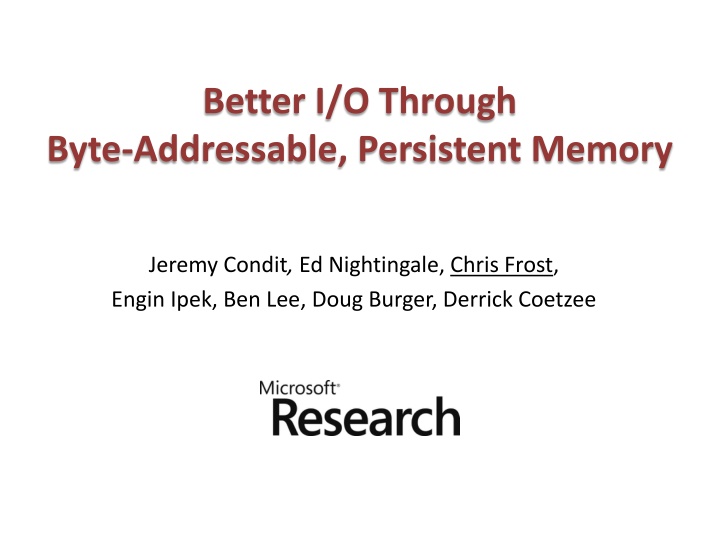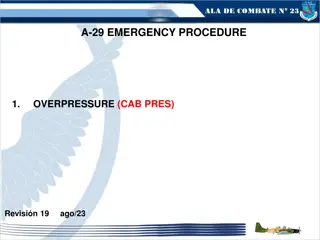
Innovative Approaches to Byte-Addressable Persistent Memory in Storage Systems
Explore the world of byte-addressable persistent memory with cutting-edge technologies like BPRAM and Phase Change Memory. Discover new storage paradigms, design principles, and hardware support for building fast and reliable systems. Learn about advancements in file system operations, atomicity, and caching strategies for improved performance and durability.
Download Presentation

Please find below an Image/Link to download the presentation.
The content on the website is provided AS IS for your information and personal use only. It may not be sold, licensed, or shared on other websites without obtaining consent from the author. If you encounter any issues during the download, it is possible that the publisher has removed the file from their server.
You are allowed to download the files provided on this website for personal or commercial use, subject to the condition that they are used lawfully. All files are the property of their respective owners.
The content on the website is provided AS IS for your information and personal use only. It may not be sold, licensed, or shared on other websites without obtaining consent from the author.
E N D
Presentation Transcript
Better I/O Through Byte-Addressable, Persistent Memory Jeremy Condit, Ed Nightingale, Chris Frost, Engin Ipek, Ben Lee, Doug Burger, Derrick Coetzee
A New World of Storage DRAM + Fast + Byte-addressable - Volatile Disk / Flash + Non-volatile - Slow - Block-addressable 2
A New World of Storage Byte-addressable, Persistent RAM BPRAM + Fast + Byte-addressable + Non-volatile How do we build fast, reliable systems with BPRAM? 3
Phase Change Memory Most promising form of BPRAM Melting memory chips in mass production Nature, 9/25/09 4
Phase Change Memory slow cooling -> crystalline state (1) phase change material (chalcogenide) fast cooling -> amorphous state (0) Properties Reads: 2-4x DRAM Writes: 5-10x DRAM Endurance: 108+ electrode 5
A New World of Storage Byte-addressable, Persistent RAM BPRAM + Fast + Byte-addressable + Non-volatile Disk / Flash How do we build fast, reliable systems with BPRAM? + Non-volatile - Slow - Block-addressable This talk: BPFS, a file system for BPRAM Result: Improved performance and reliability 6
Goal New guarantees for applications File system operations will commit atomically and in program order Your data is durable as soon as the cache is flushed New mechanism: short-circuit shadow paging 7
Design Principles 1. Eliminate the DRAM buffer cache; use the L1/L2 cache instead 2. Put BPRAM on the memory bus 3. Provide atomicity and ordering in hardware Write A Write B 8
Outline Intro File System Hardware Support Evaluation Conclusion 9
BPRAM in the PC BPRAM and DRAM are addressable by the CPU L1 L2 Memory bus Physical address space is partitioned DRAM BPRAM PCI/IDE bus BPRAM data may be cached in L1/L2 HD / Flash 10
BPFS: A BPRAM File System Guarantees that all file operations execute atomically and in program order Despite guarantees, significant performance improvements over NTFS on the same media Short-circuit shadow paging often allows atomic, in-place updates 11
BPFS: A BPRAM File System root pointer inode file indirect blocks inodes file directory file 12
Enforcing FS Consistency Guarantees What happens if we crash during an update? Disk: Use journaling or shadow paging BPRAM: Use short-circuit shadow paging 13
Review 1: Journaling Write to journal, then write to file system file system A A B B journal A B Reliable, but all data is written twice 14
Review 2: Shadow Paging Use copy-on-write up to root of file system file s root pointer A B A B Any change requires bubbling to the FS root Small writes require large copying overhead 15
Short-Circuit Shadow Paging Inspired by shadow paging Optimization: In-place update when possible 16
Short-Circuit Shadow Paging Inspired by shadow paging Optimization: In-place update when possible file s root pointer A B A B Uses byte-addressability and atomic 64b writes 17
Opt. 1: In-Place Writes Aligned 64-bit writes are performed in place Data and metadata file s root pointer in-place write 18
Opt. 2: Exploit Data-Metadata Invariants Appends committed by updating file size file s root pointer + size file size update in-place append 19
BPFS Example root pointer inode file indirect blocks inodes add entry remove entry directory Cross-directory rename bubbles to common ancestor directory file 20
Outline Intro File System Hardware Support Evaluation Conclusion 21
Problem 1: Ordering ... CoW Commit ... L1 / L2 BPRAM 22
Problem 2: Atomicity ... CoW Commit ... L1 / L2 BPRAM 23
Enforcing Ordering and Atomicity Ordering Solution: Epoch barriers to declare constraints Faster than write-through Important hardware primitive (cf. SCSI TCQ) Atomicity Solution: Capacitor on DIMM Simple and cheap! 24
Ordering and Atomicity Ineligible for eviction! 2 ... CoW Barrier Commit ... 1 1 1 L1 / L2 MP works too (see paper) BPRAM 25
Outline Intro File System Hardware Support Evaluation Conclusion 26
Methodology Built and evaluated BPFS in Windows Three parts: Experimental: BPFS vs. NTFS on DRAM Simulation: Epoch barrier evaluation Analytical: BPFS on PCM 27
Microbenchmarks Append n Bytes Random n Byte Write 2 10 Thousands NOT DURABLE! 1.6 8 1.2 6 Time (s) 0.8 4 NOT DURABLE! DURABLE! NTFS - Disk NTFS - RAM BPFS - RAM 0.4 2 DURABLE! 0 0 8 64 512 4096 8 64 512 4096 28
BPFS Throughput On PCM 1 1 BPFS - PCM Execution Time (vs. NTFS / Disk) Projected Throughput 0.75 0.75 0.5 0.5 0.25 0.25 0 0 NTFS Disk NTFS RAM BPFS RAM BPFS PCM (Proj) 0 200 400 600 800 Sustained Throughput of PCM (MB/s) 29
Conclusions BPRAM changes the trade-offs for storage Use consistency technique designed for medium Short-circuit shadow paging: improves performance improves reliability Bonus: PCM chips on display at poster session! 30





